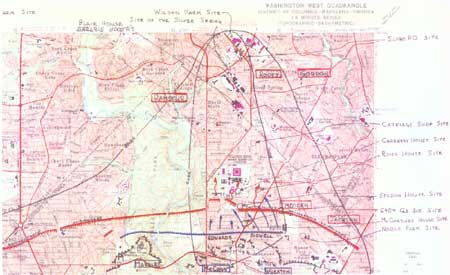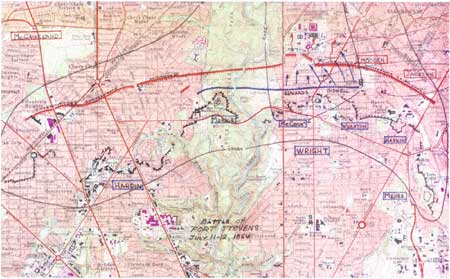|
Civil War Defenses of Washington
Historic Resource Study |

|
| PART I |
NOTE ABOUT THE MAPS
For some of the important Civil War battlefields, extensive information is available including maps that show where the various units were at certain times during the battle and the homes, farms and other features that existed at the time of the fighting. Unfortunately, the Battle of Fort Stevens has not received a lot of attention but there are a few useful items available.
Soon after the battle, General Barnard reported [ORA, I, 37, Part 2 (serial 71), 414-16], on July 22, that in compliance with instructions from Major General C.C. Augur, commander of the Department of Washington, he "caused the ground occupied by the rebel troops to be surveyed and the location of camps noted" and inclosed a sketch showing all this. He also inclosed a report from Lieutenant J.H. Oberteuffer, Jr. and Mr. E. Hergesheimer, U.S. Coast Survey, who also made the sketch, in which they gave some detail about the movements and locations of the enemy during the battle. But, the sketch is unavailable [I looked for the sketch and Michael Musick, the Civil War specialist at the National Archives, did also but neither of us was able to find it]. Hopefully, this sketch will show up somewhere soon!
In 1991, Congress created the Civil War Sites Advisory Commission to determine which Civil War battles were the most historically significant, which ones were under historic preservation threat, both short and long term; and devise new methods for saving them other than spending millions and millions of dollars for them. Between 1991 and 1993, the Commission conducted surveys of the historically significant battlefields, including Fort Stevens, and completed written reports and maps showing where the actual battlefield is, where the troops were and marked the important features for each. The Battle of Fort Stevens map, researched and drawn by David Murphy, of the Capital Region, National Park Service, appears to be the best extant one, by far, showing the location of the troops and features on the battlefields. A copy of this map is included, in two parts, within this report.
In 1863, April to September, Private A.A. Hodasevich, Second Artillery, Pennsylvania Volunteer Battalion, drew, in the field with a plane table, "a map of distances to principal points in " for each fort in the brigade [First Brigade, Defenses North of the Potomac]. The map includes 5 large sheets of paper that show the environs of forts DeRussy, Stevens, Slocum. Totten, Slemmer, Bunker Hill, Saratoga, Thayer, Lincoln, and batteries Sill and Jameson, showing fortifications, roads, houses, names of residents, fences, vegetation, drainage and relief by contour lines. This multi-paged map, among the holdings of the Geography and Map Division, Library of Congress [G3851.S5 1863 .H61 Vault, 189 L. Sheet 1], therefore, shows the features, including house, farms, etc., on the Fort Stevens battlefield, as they were just one year before the battle.

|
| (click on image for an enlargement in a new window) |

|
| (click on image for an enlargement in a new window) |
| <<< Previous | <<< Contents >>> | Next >>> |
cwdw/hrs/maps.htm
Last Updated: 29-Oct-2004